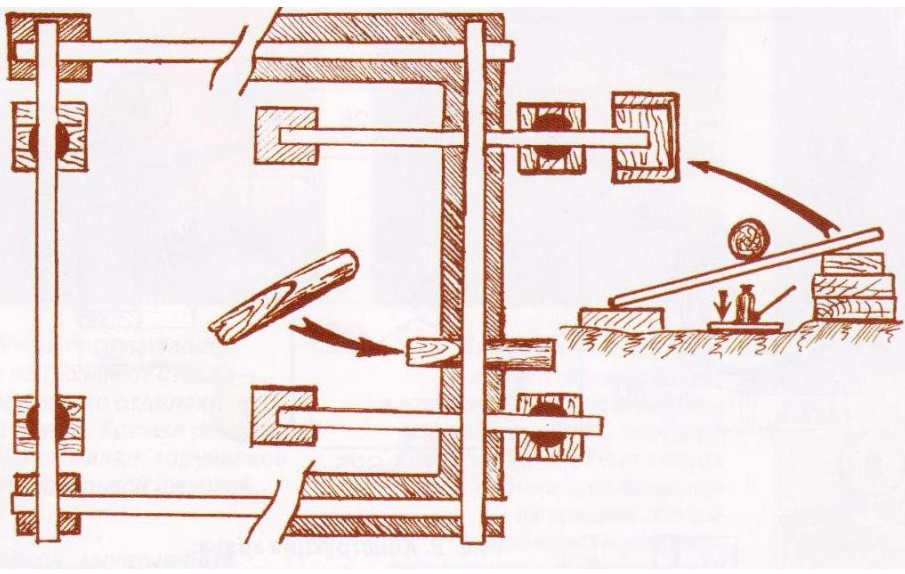Replacing a couple of logs of the lower crown or the entire crown of the log house is a laborious job, but technically not very difficult. However, unfortunately, no one will give a ready-made recipe. Repairs are sometimes more difficult than new construction — the flight of your creative imagination is limited by the rigid framework of the existing structure with all its advantages and flaws. For each specific case, we have to look for our own technical solution. Nevertheless, there are ways and techniques that will come in handy in any case.
Diagnosis of the crown
Your house is “sick”, and the “disease” is progressing — the wood is sick. Start by making a diagnosis: it is important to understand the cause of the destruction of logs and foundations.Free the lower crown and the base part from everything nailed, leaned, poured, get to the natural soil, and not only from the outside, but also from the inside.
No matter how strong the logs of the crown may seem when examined, knock them with a hammer, do not regret it, and it will become clear where the healthy wood is and where the dust is. Cases when the log has decayed along its entire length are quite rare. And it can only mean that you realized too late. Determine the most durable areas — places where jacks, temporary supports, wedges, etc. are installed.
We put the jack
Usually the core and the upper side of the log retain sufficient strength. Where you will put the lifting devices, remove the decayed layer. The jack is the only tool you will need. In principle, it is possible to use lifting mechanisms of any type with sufficient lifting capacity (from five tons). For example, the railway is good, but not everyone has seen it, but an ordinary automobile hydraulic jack is available in every full-fledged truck. Although you need to have two such tools to work, you can do with one if you want.
To determine the degree and place of destruction is only half the battle. It is important to understand the reason. The first enemy of wood is moisture, and only then insects. Find where the waterproofing is broken, where it is illiterate, that is, when the insulating layer, the same roofing material, prevents the free flow of rainwater, delays it between the foundation and the crown. It is necessary to eliminate the causes in order not to have to repeat such, in general, thankless work in a couple of years.
Changing logs
The technology of replacing the lower crown is shown in the following figures.

Figure 1 (left). This figure shows a variant of lifting a log cabin installed on the foundations of the pillars. The log house is raised, the lower log of the dressing 1 is free, and it can be removed. Install temporary supports 4 under the bottom log of the second crown 6, and you can lower the jacks. Together with them, the upper log of the lower crown will also fall 2. Replace it with a new one and press the jack so that temporary supports can be removed 4. The jack should stand on a rigid cushion 5. It can serve as a shield, approximately 50×50 cm in size, made of durable boards. You can use a worn-out wheel disk filled with sand. The head of the jack rod rests not on a log, but on a metal plate 3 or a thick, solid board (which, however, is worse). Even with a recessed rod, the jack has its own height, so most often it is necessary to make a tunnel. From the drawing, it is easy to imagine the initial moment of lifting, the jack rod is recessed, the log house is lowered.
Fig. 1 (right). The same picture, only from the side of the lower log of the dressing. This log has already been removed, 4 temporary supports have been installed. These supports are not necessarily the same as in the picture. You can use any improvised material — logs, stacked boards, concrete block. It is only important that all this is durable and gives a minimum draft. The figure shows the moment when the old logs of the crown are removed and a new upper log of the dressing is installed, which is pressed by a jack. Another half a centimeter up — and you can remove the temporary supports and lay the lower log of the dressing on the foundations, after that the jacks are lowered synchronously and slowly. Of course, first we need to repair the foundations, restore insulation. And the logs of the lower crown have already been prepared, and tow for caulking is also available in sufficient quantity.

Fig. 2 (left). The log house stands on a ribbon foundation. We will have to look for weak points in the foundation from the side of the upper log of the dressing 1 (the lower one is not shown in the figure), punch through holes sufficient to get a lever 2 under the log. The lever can serve as a channel, a block, just a log with two meter long ends. It is advisable to install the jacks as close as possible to the foundation 4, and the supports 3 under the inner end of the lever, on the contrary, away. The support 3 for the inner end of the lever can be a log, a stack of strong short but wide boards, etc.
Fig. 2 (right). The log house is raised to a height sufficient to release the lower log of the dressing 1 and remove it. Before lowering the jacks, install temporary supports under the second lower log of the dressing, in principle, the same as in Fig. 1 (right). But in the case of a ribbon foundation, this is much easier: there is no need to prepare platforms for supports, they will be completely replaced by the foundation itself, and the same wedges 3 can serve as supports, they still need to be removed before lowering. And the procedure for replacing the logs of the lower crown is the same: first, the upper log 2 is changed, the same levers are pressed, the lower log of the dressing is laid on the foundation tape, the jacks and levers are removed. The work is finished, it remains only to seal the technological holes in the foundation, the ones where the levers were inserted.

Fig. 3. Options for installing jacks in cases with columnar and ribbon foundations. In the upper right corner and on a separate fragment, the case is shown when it is not possible to use wedges (part of the foundation has been destroyed, or a section of the log has thoroughly rotted). It is necessary to prop up the outer end of the lever protruding behind the jack.


















